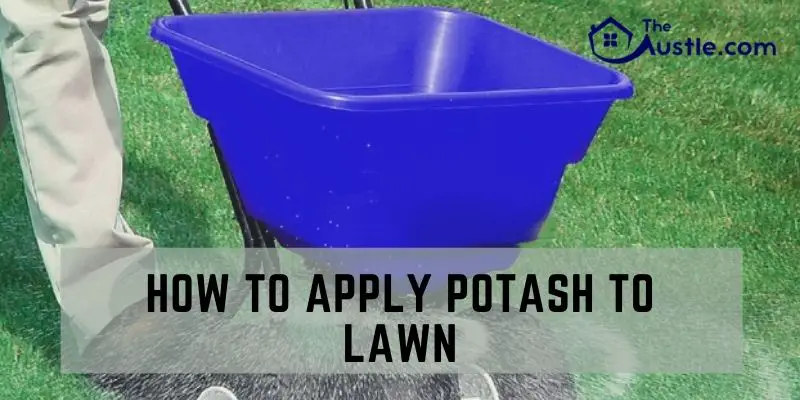Do you know how to apply potash to lawn so easily. Then, you may follow our suggestion.
Potassium is an essential nutrient for healthy grass development. It not only keeps your lawn healthy against disease but also helps in photosynthesis and protein synthesis.
If you suspect your grass has a potassium deficiency, and get a soil sample for testing. It is the best way to tell if your plants could benefit from potash.
You can choose a potash fertilizer and apply it based on the test results.
How To Apply Potash To Lawn
Lawn fertility is an essential aspect of lawn care. So, it is vital to know how to apply potash to lawn and how it affects your yard.
The appropriate fertilizer should be chosen based on soil type, soil test results, and other factors, including personal preference or legislation.
Professional testing results will give specific recommendations for how to fertilize the soil to create optimal growing conditions and how much potassium your soil requires for good grass growth. So, check below:
Step: 1
Before using potash to your lawn, contact your local agricultural extension office, horticultural society, or plant nursery for advice. Then, test your soil and see how much potassium it contains. If the ground contains high potassium, then there is no need to apply. But if the potassium is low, then use it in your lawn.
Step: 2
You must calculate how much potash need to apply in your lawn. You should check the packaging for specific application ratios.
Step: 3
If you apply a stable form of potash, such as potassium chlorate or potassium sulfate. Apply it as a topdressing before planting or mix it into the top layer of soil near your seeds at planting time.
The easiest way to apply it is with a fertilizer broadcaster, a wheelbarrow-like device that spreads the fertilizer onto the ground. Some gardeners and farmers recommend that potash use into the soil to get it closer to the root zone.
Step: 4
Apply the potash in your lawn based on soil test results. Follow the result recommendations as a guide to determine how much potash you need to apply to a given area. You can find the area of your garden by multiplying its length by its width.
Multiply the amount of potash you need per 1,000 square feet by the city of your lawn divided by 1000. A 0-0-60 fertilizer is 60% potash and 40% filler, so you need another calculation to figure out how much of the compost to apply. Divide the amount of potash you need by the percentage in your fertilizer.
Step: 5
If the grass suffers from a potassium deficiency during the growing season, apply liquid potassium thiosulfate fertilizer. It can give your plants a significant boost. You spray it directly onto the leaves according to the directions on the package.
When To Use Potash
A potassium deficiency will cause the edges of leaves near the plant’s bottom to turn yellow or brown. Over time, the leaves higher up on the plant will also be affected. So, apply potash fertilizer.
Selecting Potash Fertilizer
Choose a high-K fertilizer for high potassium content. Most fertilizers are N-P-K fertilizers.
These three letters refer to the elements nitrogen (N), phosphorous (P), and potassium (K). Fertilizers label with three numbers that indicate the percentages of these elements in the fertilizer, always in the same order.
You may apply Potassium chloride known as murate of potash, which is the most commonly used type of potash fertilizer. The cost is cheap and contains high-k.
You may use potassium thiosulfate if you need a fast-acting potassium boost.
If your grass need for extra nutrients, get potassium sulfate or potassium-magnesium sulfate.
Effect of Potassium
Potassium helps to build thicker cell walls of the grass. So, the plant grows so strong that it can withstand external stresses such as drought, heat, cold, and disease.
When You Add Potash In Lawn
Fall and spring are the most common times for potassium applications in the soil. Some gardeners add potassium in the winter so that it is available for the grass when they start to grow in the spring. A fertilizer should apply with less nitrogen to slow growth and more potash to build stress tolerance.
Tips
Excess potassium in the soil will not hurt your plants, but too much can make it harder for your plants to absorb the magnesium.
Many soils are already rich in potassium, and it is always a good idea to get your soil tested before you fertilize your lawn with potash.
Don’t apply potassium thiosulfate to your plants leaves if it’s hotter than 90 °F (32 °C). High temperatures cause the small pores on the leaves’ surface to close, so your grass will not absorb the nutrients if it’s too hot.
Warnings
Too much potassium likely means an excess of nitrogen or phosphorus can be harmful. Over applying nitrogen can create too much top growth or possibly burning the grass plants.
Conclusion
Everyone wants to see his front door with lush and green grass. You do not need a landscape artist. Whether you start from seed or sod, it all comes down to proper planning and fertile soil. So, you need to know how to apply potash to lawn. We believe the article helps to fulfill your desired need.

